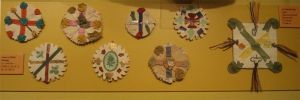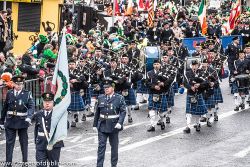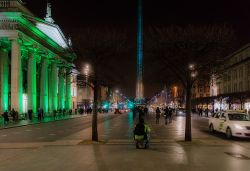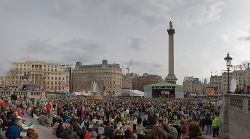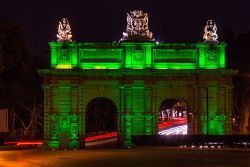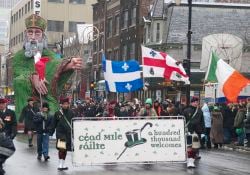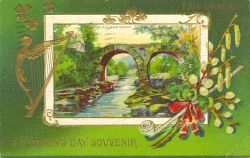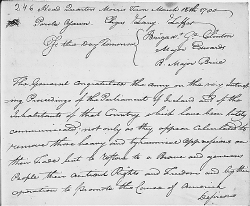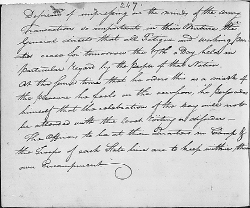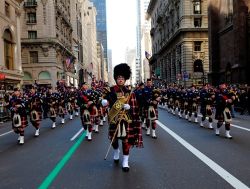Saint Patrick's Day
| Saint Patrick's Day | |
|---|---|
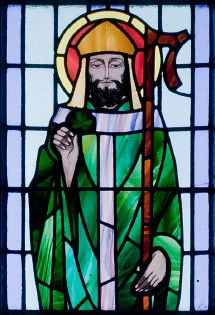
| |
| Saint Patrick depicted in a stained-glass window at Saint Benin's Church, Ireland | |
| Official name | Saint Patrick's Day[1] |
| Also called |
|
| Observed by |
|
| Type | Ethnic, national, Christian |
| Significance | Feast day of Saint Patrick, commemoration of the arrival of Christianity in Ireland[3] |
| Date | 17 March |
| Observances | Attending mass or service |
Saint Patrick's Day, or the Feast of Saint Patrick (Irish: Lá Fhéile Pádraig), is a cultural and religious celebration held on March 17, the traditional death date of Saint Patrick (c. 385), the foremost patron saint of Ireland. Celebrations generally involve public parades and festivals, Irish traditional music sessions (céilithe), and the wearing of green attire or shamrocks. Modern celebrations have been greatly influenced by those of the Irish diaspora, particularly those that developed in North America.
Saint Patrick's Day is celebrated in more countries than any other national festival, both by those within the Irish diaspora and even in cultures that have little or no connection to Irish heritage. Despite the tendency of many of the celebrations to demean Irish culture, there is a display of pride in their heritage that reveals the resilience of the Irish to overcome the challenges that led to their migration from their homeland and to being accepted within new cultures.
Saint Patrick
Saint Patrick was a fifth-century Romano-British Christian missionary and bishop in Ireland. Much of what is known about Saint Patrick comes from the Confessio (Confession), which was allegedly written by Patrick himself. It is believed that he was born in Roman Britain in the fourth century, into a wealthy Romano-British family. His father was a deacon and his grandfather was a priest in the Christian church. According to the Confessio, at the age of sixteen, he was kidnapped by Irish raiders and taken as a slave to Gaelic Ireland.[4] It says that he spent six years there working as a shepherd and that during this time he found God. God told Patrick to flee to the coast, where a ship would be waiting to take him home. After making his way home, Patrick went on to become a priest.
According to tradition, Patrick then returned to Ireland to convert the pagan Irish to Christianity. He spent many years evangelizing in the northern half of Ireland and converted "thousands." Patrick's efforts against the druids were eventually turned into an allegory in which he drove "snakes" out of Ireland, despite the fact that snakes were not known to inhabit the region.
Tradition holds that he died on March 17, and was buried at Downpatrick. Over the following centuries, many legends grew up around Patrick and he became Ireland's foremost saint.
History of the Celebration
Saint Patrick's Day was made an official Christian feast day in the early seventeenth century, observed by the Catholic Church, the Anglican Communion (especially the Church of Ireland), the Eastern Orthodox Church, and the Lutheran Church. The day commemorates Saint Patrick and the arrival of Christianity in Ireland.[3]
Celebrations included Irish traditional music sessions (céilithe), as well as formal gatherings such as banquets and dances, and the wearing of green attire or shamrocks: "The religious occasion did involve the wearing of shamrocks, an Irish symbol of the Holy Trinity, and the lifting of Lenten restrictions on drinking."[5]
The 40-day period (not counting Sundays) prior to Easter is known as Lent, a time of prayer and fasting. Pastors of Irish-American parishes often supplied "dispensations" for St. Patrick's Day, enabling parishioners to forego Lenten sacrifices in order to celebrate the feast of their patron saint.[6]
Later, the day became a celebration of the heritage and culture of the Irish in general: "In nineteenth-century America it became a celebration of Irishness more than a religious occasion, though attending Mass continues as an essential part of the day."[5]
Today's Saint Patrick's Day celebrations have been greatly influenced by those that developed among the Irish diaspora, especially in North America. Saint Patrick's Day parades began in North America in the eighteenth century but did not spread to Ireland until the twentieth century. Until the late twentieth century, Saint Patrick's Day was often a bigger celebration among the diaspora than it was in Ireland.[7]
Traditions
Celebrations generally involve public parades and festivals, Irish traditional music sessions (céilithe), and the wearing of green attire or shamrocks.[5] There are also formal gatherings such as banquets and dances, although these were more common in the past. More effort is made to use the Irish language, especially in Ireland, where the week of Saint Patrick's Day is "Irish language week." Christians who belong to liturgical denominations also attend church services[5]
Saint Patrick's Day parades began in North America in the eighteenth century but did not spread to Ireland until the twentieth century.[7] The participants generally include marching bands, the military, fire brigades, cultural organizations, charitable organizations, voluntary associations, youth groups, fraternities, and so on. However, over time, many of the parades have become more akin to a carnival.
Like many other forms of carnival, St. Patrick's Day is a feast day, a break from Lent in which adherents are allowed to temporarily abandon rigorous fasting by indulging in the forbidden. Since alcohol is often proscribed during Lent the copious consumption of alcohol is seen as an integral part of St. Patrick's day.[8]
Historically the Lenten restrictions on eating and drinking alcohol were lifted for the day, which has encouraged and propagated the holiday's tradition of alcohol consumption.[5] The Saint Patrick's Day custom of "drowning the shamrock" or "wetting the shamrock" was historically popular, especially in Ireland. At the end of the celebrations, a shamrock is put into the bottom of a cup, which is then filled with whiskey, beer, or cider. It is then drunk as a toast to Saint Patrick, Ireland, or those present. The shamrock would either be swallowed with the drink or taken out and tossed over the shoulder for good luck.[9]
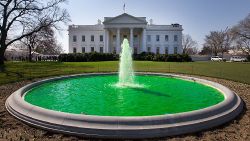
Irish Government Ministers travel abroad on official visits to various countries around the globe to celebrate Saint Patrick's Day and promote Ireland.[10][11] The most prominent of these is the visit of the Irish Taoiseach (Irish Prime Minister) with the U.S. President which happens on or around Saint Patrick's Day.[12][13]
Since 2010, famous landmarks have been lit up in green on Saint Patrick's Day as part of Tourism Ireland's "Global Greening Initiative" or "Going Green for St Patrick´s Day". The Sydney Opera House and the Sky Tower in Auckland were the first landmarks to participate and since then over 300 landmarks in fifty countries across the globe have gone green for Saint Patrick's day.[14]
Wearing green
On Saint Patrick's Day, it is customary to wear shamrocks, green clothing or green accessories. Saint Patrick is said to have used the shamrock, a three-leaved plant, to explain the Holy Trinity to the pagan Irish.[15] This story first appears in writing in 1726, though it may be older.
In pagan Ireland, three was a significant number and the Irish had many triple deities, a fact that may have aided St Patrick in his evangelization efforts:
There is no evidence that the clover or wood sorrel (both of which are called shamrocks) were sacred to the Celts in any way. However, the Celts had a philosophical and cosmological vision of triplicity, with many of their divinities appearing in three. Thus when St Patrick, attempting to convert the Druids on Beltane, held up a shamrock and discoursed on the Christian Trinity, the three-in-one god, he was doing more than finding a homely symbol for a complex religious concept. He was indicating knowledge of the significance of three in the Celtic realm, a knowledge that probably made his mission far easier and more successful than if he had been unaware of that number's meaning.[16]
Roger Homan suggested, "We can perhaps see St Patrick drawing upon the visual concept of the triskele when he uses the shamrock to explain the Trinity."[17]
In some ways, though, the Christian mission resonated: pre-Christian devotion was characterized by, for example, the worship of gods in groups of three, by sayings collected in threes (triads), and so on – from all of which the concept of the Holy Trinity was not so very far removed. Against this backdrop the myth of Patrick and his three-leafed shamrock fits quite neatly.[18]
While the shamrock may not have been sacred to the Irish, it may have represented the regenerative powers of nature, and was recast in a Christian context—icons of St Patrick often depict the saint "with a cross in one hand and a sprig of shamrocks in the other."[9]
The first association of the color green with Ireland is from the eleventh century pseudo-historical book Lebor Gabála Érenn (The Book of the Taking of Ireland), which forms part of the Mythological Cycle in Irish Mythology. It describes the story of Goídel Glas who is credited as the eponymous ancestor of the Gaels and creator of the Goidelic languages (Irish, Scottish Gaelic, Manx).[19][20] In the story Goídel Glas, who was the son of Scota and Niul, was bitten by a snake and was saved from death by Moses placing his staff on the snakebite. As a reminder of the incident he would retain a green mark that would stay with him and he would lead his people to a land that would be free of snakes.[21] This is emphasized in his name Goídel which was anglicized to the word Gaelic and Glas which is the Irish word for green.[19][20]
Green ribbons and shamrocks have been worn on St Patrick's Day since at least the 1680s.[7] Throughout the following centuries, the color green and its association with St Patrick's Day has grown.
The wearing of the 'St Patrick's Day Cross' was also a popular custom in Ireland until the early twentieth century. This was a Celtic Christian cross made of paper that was "covered with silk or ribbon of different colours, and a bunch or rosette of green silk in the centre."[7]
Celebrations by region
Saint Patrick's Day is a public holiday in the Republic of Ireland,[22] Northern Ireland,[23] the Canadian province of Newfoundland and Labrador (for provincial government employees), and the British Overseas Territory of Montserrat. It is also widely celebrated in the United Kingdom, Canada, United States, Brazil, Argentina, Australia, and New Zealand, especially amongst Irish diaspora. Saint Patrick's Day is celebrated in more countries than any other national festival.[7] Modern celebrations have been greatly influenced by those of the Irish diaspora, particularly those that developed in North America.
Ireland
Saint Patrick's feast day, as a kind of national day, was already being celebrated by the Irish in Europe in the ninth and tenth centuries. In later times, he became more and more widely seen as the patron of Ireland.[24] Saint Patrick's feast day was finally placed on the universal liturgical calendar in the Catholic Church due to the influence of Waterford-born Franciscan scholar Luke Wadding[25] in the early 1600s, Saint Patrick's Day thus became a holy day of obligation for Roman Catholics in Ireland. It is also a feast day in the Church of Ireland, which is part of the worldwide Anglican Communion.
In 1903, St Patrick's Day became an official public holiday in Ireland. This was thanks to the Bank Holiday (Ireland) Act 1903, an act of the United Kingdom Parliament introduced by Irish Member of Parliament James O'Mara. The first St Patrick's Day parade in Ireland was held in Waterford in 1903. The week of St Patrick's Day 1903 had been declared Irish Language Week by the Gaelic League and in Waterford they opted to have a procession on Sunday March 15. The procession comprised the Mayor and members of Waterford Corporation, the Trades Hall, the various trade unions and bands.
On St Patrick's Day 1916, the Irish Volunteers—an Irish nationalist paramilitary organization—held parades throughout Ireland. The authorities recorded 38 St Patrick's Day parades, involving 6,000 marchers, almost half of whom were said to be armed. The following month, the Irish Volunteers launched the Easter Rising against British rule. This marked the beginning of the Irish revolutionary period and led to the Irish War of Independence and Civil War. During this time, St Patrick's Day celebrations in Ireland were muted, although the day was sometimes chosen to hold large political rallies.[7] The celebrations remained low-key after the creation of the Irish Free State; the only state-organized observance was a military procession and trooping of the colours, and an Irish-language mass attended by government ministers.[7] In 1927, the Irish Free State government banned the selling of alcohol on St Patrick's Day, although it remained legal in Northern Ireland. The ban was not repealed until 1961.[7]
The first official, state-sponsored St Patrick's Day parade in Dublin took place in 1931.[26] On two occasions, parades across the Republic of Ireland have been cancelled from taking place on St Patrick's Day, with both years involving health and safety reasons: In 2001, as a precaution to the foot-and-mouth outbreak, St Patrick's Day celebrations were postponed to May,[27] and in 2020, as a consequence to the severity of the COVID-19 pandemic, the St Patrick's Day Parade was cancelled outright.[28]
As well as Dublin, many other cities, towns, and villages in Ireland hold their own parades and festivals, including Cork, Belfast, Derry, Galway, Kilkenny, Limerick, and Waterford.
In Northern Ireland, the celebration of St Patrick's Day was affected by sectarian divisions.[7] A majority of the population were Protestant Ulster unionists who saw themselves as British, while a substantial minority were Catholic Irish nationalists who saw themselves as Irish. Although it was a public holiday, Northern Ireland's unionist government did not officially observe St Patrick's Day. During the conflict known as the Troubles (late 1960s–late 1990s), public St Patrick's Day celebrations were rare and tended to be associated with the Catholic community. Since the end of the conflict in 1998 there have been cross-community St Patrick's Day parades in towns throughout Northern Ireland, which have attracted thousands of spectators.[7]
The biggest celebrations outside the cities are in Downpatrick, County Down, where Saint Patrick is said to be buried.
In the mid-1990s the government of the Republic of Ireland began a campaign to use St Patrick's Day to showcase Ireland and its culture. The government set up a group called St Patrick's Festival, with the aims:
- To offer a national festival that ranks amongst all of the greatest celebrations in the world
- To create energy and excitement throughout Ireland via innovation, creativity, grassroots involvement, and marketing activity
- To provide the opportunity and motivation for people of Irish descent (and those who sometimes wish they were Irish) to attend and join in the imaginative and expressive celebrations
- To project, internationally, an accurate image of Ireland as a creative, professional and sophisticated country with wide appeal.[29]
The first St Patrick's Festival was held on March 17, 1996. In 1997, it became a three-day event, and by 2000 it was a four-day event. By 2006, the festival was five days long; more than 675,000 people attended the 2009 parade. Overall, the 2009 five-day festival saw almost 1 million visitors, who took part in festivities that included concerts, outdoor theatre performances, and fireworks.
Elsewhere in Europe
England
Christian denominations in Great Britain observing his feast day include The Church of England and the Roman Catholic Church.[30]
In England, the British Royals traditionally present bowls of shamrock to members of the Irish Guards, a regiment in the British Army, following Queen Alexandra introducing the tradition in 1901.[31] Fresh Shamrocks are presented to the Irish Guards, regardless of where they are stationed, and are flown in from Ireland.
While some Saint Patrick's Day celebrations were conducted openly in Britain pre-1960s, this changed with the IRA's bombing campaign on mainland Britain which resulted in a suspicion of all things Irish and those who supported them. People of Irish descent simply wore a sprig of shamrock on Saint Patrick's day in private or attending specific events. Since the the Good Friday Agreement, people of Irish descent openly wear a sprig of shamrock to celebrate their Irishness.[7]
Many major cities hold Saint Patrick's Day parades: London, since 2002, has had an annual Saint Patrick's Day parade which takes place on weekends around the 17th, usually in Trafalgar Square. Birmingham holds the largest Saint Patrick's Day parade in Britain with a parade over a two-mile (3 km) route through the city center. The organizers describe it as the third biggest parade in the world after Dublin and New York.[32] Liverpool has a long-standing celebration on St Patrick's Day in terms of music, cultural events and the parade. Manchester hosts a two-week Irish festival in the weeks prior to Saint Patrick's Day. The festival includes an Irish Market based at the city's town hall which flies the Irish tricolour opposite the Union Flag, a large parade as well as a large number of cultural and learning events throughout the two-week period.[33]
Scotland
Glasgow has a considerable Irish population as a result of Irish immigration during the late eighteenth and early nineteenth centuries.[34] Due to this large Irish population, there are many Irish-themed pubs and Irish interest groups who hold yearly celebrations on Saint Patrick's day in Glasgow. Glasgow has held a yearly Saint Patrick's Day parade and festival since 2007.[35]
The Scottish town of Coatbridge had a large Irish population arrive in the nineteenth and twentieth centuries, resulting in the town being known as "Little Ireland." It has a Saint Patrick's Day Festival which includes celebrations and parades in the town center.[36]
Malta
The first Saint Patrick's Day celebrations in Malta took place in the early twentieth century by soldiers of the Royal Dublin Fusiliers who were stationed in Floriana. The Irish diaspora in Malta continued to celebrate the feast annually. Today, Saint Patrick's Day is mainly celebrated in Spinola Bay and Paceville areas of St Julian's,[37] although other celebrations still occur at Floriana and other locations. Thousands of Maltese attend the celebrations, which are more associated with drinking beer than traditional Irish culture.[38]
Russia
Despite having little connection with Saint Patrick or Ireland, Russians have celebrated Saint Patrick's Day since 1992. In 2017, the Russian Orthodox Church added the feast day of Saint Patrick to its liturgical calendar, to be celebrated on 30 March [O.S. 17 March] .[39]
Bosnia and Herzegovina
Sarajevo, the capital city of Bosnia and Herzegovina has a large Irish expatriate community. They established the Sarajevo Irish Festival in 2015, which is held for three days around and including Saint Patrick's Day. The festival organizes an annual a parade, hosts Irish theatre companies, screens Irish films and organizes concerts of Irish folk musicians.[40]
Americas
Canada
One of the longest-running and largest Saint Patrick's Day (French: le jour de la Saint-Patrick) parades in North America has taken place annually in Montreal since 1824,[41] St Patrick's Day itself, however, has been celebrated in Montreal since as far back as 1759 by Irish soldiers in the Montreal Garrison following the British conquest of New France.
In Quebec City, there was a parade from 1837 to 1926; it returned in 2010 after more than 84 years. For the occasion, a portion of the New York Police Department Pipes and Drums were present as special guests.
There has been a parade held in Toronto since at least 1863.[42]
United States
Although a legal holiday only in Suffolk County, Massachusetts (where it is recognized alongside Evacuation Day)[43] and Savannah, Georgia[44] Saint Patrick's Day is nonetheless widely recognized and celebrated throughout the United States. It has been celebrated since the beginning of the seventeenth century, and is primarily celebrated as a recognition of Irish and Irish American culture; celebrations include prominent displays of the color green, eating and drinking, religious observances, and numerous parades.
The first recorded St Patrick’s Day celebration in America was in St. Augustine, Florida, in the year 1600, organized by Ricardo Artur (Richard Arthur) from Ireland who served as St. Augustine’s parish priest.[45][46] The first Saint Patrick's Day Parade was also in St. Augustine in 1601; the oldest Saint Patrick's Day parade in the world.[47]
The Charitable Irish Society of Boston organized the first observance of Saint Patrick's Day in the Thirteen Colonies in 1737.[48] Surprisingly, the celebration was not Catholic in nature, Irish immigration to the colonies having been dominated by Protestants. The society's purpose in gathering was simply to honor its homeland, and although they continued to meet annually to coordinate charitable works for the Irish community in Boston, they did not meet again until 1794. During the observance of the day, individuals attended a service of worship and a special dinner.[7]
New York's first Saint Patrick's Day observance was similar to that of Boston. It was held on March 16, 1762 in the home of John Marshall, an Irish Protestant, and over the next few years informal gatherings by Irish immigrants were the norm. The first recorded parade in New York was by Irish soldiers in the British Army in 1766.[7] Today, New York City boasts not only the largest parade in the United States but one of the largest in the world.
The first documented St. Patrick's Day Celebration in Philadelphia was held in 1771. Philadelphia's Friendly Sons of St. Patrick was founded to honor St. Patrick and to provide relief to Irish immigrants in the city. In 1780, while camped in Morristown, NJ, General George Washington, an honorary member of the society, allowed his troops a holiday on 17 March "as an act of solidarity with the Irish in their fight for independence."[49]
The City of Savannah, Georgia, has hosted Saint Patrick's Day celebrations since 1824. It boasts a celebration rivaling that of New York City in size and fervor. Unlike any other cities, Savannah's historic parade is always held on March 17, not on the neighboring weekend.
Today, Saint Patrick's Day is widely celebrated in America by Irish and non-Irish alike.[30] For most Irish-Americans, this holiday is both religious and festive:
For most Irish-Americans, this holiday is partially religious but overwhelmingly festive. For most Irish people in Ireland the day has little to do with religion at all. St. Patrick's Day church services are followed by parades and parties, the latter being the best attended. The festivities are marked by Irish music, songs, and dances.[50]
Like many other forms of carnival, Saint Patrick's Day is a feast day, a break from Lent in which adherents are allowed to temporarily abandon rigorous fasting by indulging in the forbidden. Since alcohol is often proscribed during Lent the copious consumption of alcohol is seen as an integral part of Saint Patrick's day.[8]
The 40-day period (not counting Sundays) prior to Easter is known as Lent, a time of prayer and fasting. Pastors of Irish-American parishes often supplied "dispensations" for St. Patrick's Day, enabling parishioners to forego Lenten sacrifices in order to celebrate the feast of their patron saint.[6]
The consumption of artificially colored green beer is a common celebration. A notable difference between traditions widely observed in the United States versus those of Ireland is the consumption of corned beef, which is not a traditional Irish dish, but rather one that was adopted by the new immigrants upon their arrival in the nineteenth Century.
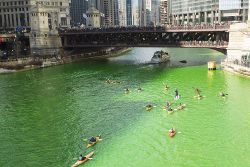
Many people choose to wear green colored clothing and items.[30] Seattle and other cities paint the traffic stripe of their parade routes green. Chicago dyes its river green and has done so since 1962 when sewer workers used green dye to check for sewer discharges and had the idea to turn the river green for Saint Patrick's Day. Indianapolis also dyes its main canal green, while Savannah dyes its downtown city fountains green. In Jamestown, New York, the Chadakoin River (a small tributary that connects Conewango Creek with its source at Chautauqua Lake) is dyed green each year.[51]
Traditionally the Taoiseach (Irish Prime Minister) presents the U.S. President a Waterford Crystal bowl filled with shamrocks on Saint Patrick's Day.[52] This tradition began in 1952 when Irish Ambassador to the U.S. John Hearne sent a box of shamrocks to President Harry S. Truman. From then on it became an annual tradition of the Irish ambassador to the U.S. to present the Saint Patrick's Day shamrock to an official in the U.S. President's administration. It was after the meeting between Taoiseach Albert Reynolds and President Bill Clinton in 1994 that the presenting of the shamrock ceremony became an annual event for the leaders of both countries for Saint Patrick's Day.[52] The Shamrock ceremony was cancelled in 2020 due to the severity of the COVID-19 pandemic.[53]
Also in 2020, for the first time in over 250 years, the parade in New York City was postponed due to concerns about the COVID-19 pandemic.[54]
Caribbean
The island of Montserrat is known as the "Emerald Island of the Caribbean" because of its founding by Irish refugees from Saint Kitts and Nevis. Montserrat is one of three places where Saint Patrick's Day is a public holiday, along with Ireland and the Canadian province of Newfoundland and Labrador. The holiday in Montserrat also commemorates a failed slave uprising that occurred on March 17, 1768.[55]
Asia
The Irish Association of Korea (IAK) has celebrated Saint Patrick's Day since 2001 in Seoul, South Korea with an outdoor festival of music, dance and more, as well as a concert in the evening. A variety of restaurants and bars also offer special celebrations.[56]
Saint Patrick's parades are now held in many locations across Japan.[57] The first parade, in Tokyo, was organized by The Irish Network Japan (INJ) in 1992.[58]
In Malaysia, the St Patrick's Society of Selangor, founded in 1925, organizes a yearly St Patrick's Ball, described as the biggest Saint Patrick's Day celebration in Asia. Guinness Anchor Berhad also organises 36 parties across the country in places like the Klang Valley, Penang, Johor Bahru, Malacca, Ipoh, Kuantan, Kota Kinabalu, Miri, and Kuching.
International Space Station
Astronauts on board the International Space Station have celebrated the festival in different ways. Irish-American Catherine Coleman played a hundred-year-old flute belonging to Matt Molloy and a tin whistle belonging to Paddy Moloney, both members of the Irish music group The Chieftains, while floating weightless in the space station on Saint Patrick's Day in 2011.[59][60]
Chris Hadfield took photographs of Ireland from Earth orbit, and a picture of himself wearing green clothing in the space station, and posted them online on Saint Patrick's Day in 2013. He also posted online a recording of himself singing "Danny Boy" in space.[61]
Criticism
Saint Patrick's Day celebrations have been criticized, particularly for their association with public drunkenness and disorderly conduct. Some argue that the festivities have become too commercialized and tacky, and have strayed from their original purpose of honoring St Patrick and Irish heritage.[7] Christian leaders in Ireland have expressed concern about the secularization of St Patrick's Day. According to Father Vincent Twomey, "It is time to reclaim St Patrick's Day as a church festival." He questioned the need for "mindless alcohol-fuelled revelry" and concluded that "it is time to bring the piety and the fun together."[62]
In other countries, there has been criticism of Saint Patrick's Day celebrations for having become too commercialized and for fostering negative stereotypes of the Irish people.[63] An example of demeaning stereotypes is the wearing of leprechaun outfits, which are based on derogatory nineteenth century caricatures of the Irish.[64]
Nevertheless, the success of Irish immigrants to the United States as shown in the celebration of Saint Patrick's Day by the population as a whole, can still be seen as valuable even if those celebrations are far from religious or even truly Irish.[65]
Sports events
- Traditionally the All-Ireland Senior Club Football Championship and All-Ireland Senior Club Hurling Championship are held on Saint Patrick's Day in Croke Park, Dublin. The Interprovincial Championship was previously held on 17 March but this was switched to games being played in Autumn.
- The Leinster Schools Rugby Senior Cup, Munster Schools Rugby Senior Cup and Ulster Schools Senior Cup are held on Saint Patrick's Day. The Connacht Schools Rugby Senior Cup is held on the weekend before Saint Patrick's Day.
- Horse racing at the Cheltenham Festival attracts large numbers of Irish people, both residents of Britain and many who travel from Ireland, and usually coincides with Saint Patrick's Day.[66]
- The Six Nations Championship is an annual international rugby Union tournament competed by England, France, Ireland, Italy, Scotland, and Wales and reaches its climax on or around Saint Patrick's Day.[67]
- The Saint Patrick's Day Test is an international rugby league tournament that is played between the US and Ireland. The game is usually held on or around March 17 to coincide with Saint Patrick's Day.
- The major professional sports leagues of the United States and Canada that play during March often wear special third jerseys to acknowledge the holiday.
Notes
- ↑ Is It "St. Patrick's Day" Or "St. Patricks Day"? Dictionary.com. Retrieved November 24, 2020.
- ↑ Aric Jenkins, Why Some Irish People Don't Want You to Call It St. Patty's Day TIME, March 15, 2017. Retrieved November 24, 2020.
- ↑ 3.0 3.1 Kevin Meethan, Alison Anderson, and Steve Miles (eds.), Tourism, Consumption and Representation (CABI, 2006, ISBN 978-0851996783).
- ↑ Confession of St. Patrick Christian Classics Ethereal Library. Retrieved November 24, 2020.
- ↑ 5.0 5.1 5.2 5.3 5.4 Willard Burgess Moore, Circles of Tradition: Folk Arts in Minnesota (Minnesota Historical Society Press, 1989, ISBN 978-0873512398).
- ↑ 6.0 6.1 James T. Fisher, Communion of Immigrants: A History of Catholics in America (Oxford University Press, 2007, ISBN 978-0195333305).
- ↑ 7.00 7.01 7.02 7.03 7.04 7.05 7.06 7.07 7.08 7.09 7.10 7.11 7.12 7.13 Mike Cronin and Daryl Adair, The Wearing of the Green: A History of St Patrick's Day (Routledge, 2001, ISBN 978-0415180047).
- ↑ 8.0 8.1 John Nagle, Multiculturalism's Double-Bind: Creating Inclusivity, Cosmopolitanism and Difference (Routledge, 2016, ISBN 978-1138260245).
- ↑ 9.0 9.1 Jack Santino, All Around the Year: Holidays and Celebrations in American Life (University of Illinois Press, 1994, ISBN 978-0252020490).
- ↑ How St Patrick’s Day Celebrations Went Global The Economist, March 9, 2018. Retrieved November 25, 2020.
- ↑ Kevin Doyle, St Patrick's Day Exodus to See Ministers Travel to 35 Countries Irish Independent, January 16, 2018. Retrieved November 25, 2018.
- ↑ Stephen Collins, A Short History of Taoisigh Visiting the White House on St Patrick’s Day Irish Times, March 11, 2017. Retrieved November 25, 2020.
- ↑ St. Patrick’s Day and Irish Heritage in American History Whitehouse, March 14, 2018. Retrieved November 25, 2020.
- ↑ St Patrick's Day: Globe Goes Green BBC News, March 17, 2018. Retrieved November 25, 2020.
- ↑ Jill Newell, Holiday has history Daily Forty-Niner 7(91) March 16, 2000. Retrieved November 25, 2020.
- ↑ Patricia Monaghan, The Encyclopedia of Celtic Mythology and Folklore (Facts on File, 2003, ISBN 978-0816045242).
- ↑ Roger Homan, The Art of the Sublime: Principles of Christian Art and Architecture (Routledge, 2017, ISBN 978-1138262799).
- ↑ Neil Hegarty The Story of Ireland: A History of the Irish People (St. Martin's Griffin, 2012, ISBN 978-1250060020).
- ↑ 19.0 19.1 John T. Koch, (ed.), Celtic Culture: A Historical Encyclopedia (ABC-CLIO, 2005, ISBN 978-1851094400).
- ↑ 20.0 20.1 James MacKillop, Myths and Legends of the Celts (Penguin, 2006, ISBN 978-0141017945)
- ↑ Robert Alexander Stewart Macalister, Lebor Gabála Érenn: The Book of the Taking of Ireland (Andesite Press, 2015, ISBN 978-1297493317).
- ↑ Public holidays in Ireland Citizens Information Board. Retrieved November 25, 2020.
- ↑ Bank holidays NI Direct. Retrieved November 27, 2020.
- ↑ Liam De Paor, St. Patrick's World, The Christian Culture of Ireland's Apostolic Age (University of Notre Dame Press, 1997, ISBN 978-0268017576).
- ↑ Luke Wadding The Catholic Encyclopedia. Retrieved November 27, 2020.
- ↑ Frederic Armao, "The Color Green in Ireland: Ecological Mythology and the Recycling of Identity" in Gilles Leydier and Alexia Martin (eds.), Environmental Issues in Political Discourse in Britain and Ireland (Cambridge Scholars Publishing, 2013, ISBN 978-1443848510), 177-191.
- ↑ Lorna Reid, St Patrick's Day parade 'postponed' Irish Independent, March 2, 2001. Retrieved November 28, 2020.
- ↑ Coronavirus: Irish St Patrick's Day parades cancelled BBC News, March 9, 2020. Retrieved November 28, 2020.
- ↑ St. Patrick's Festival was established by the Government of Ireland in November 1995 St. Patrick's Festival. Retrieved November 28, 2020.
- ↑ 30.0 30.1 30.2 Richard P. McBrien, Lives of the Saints: From Mary and St. Francis of Assisi to John XXIII and Mother Teresa (HarperOne, 2006, ISBN 978-0061232831).
- ↑ Duchess of Cambridge Presents St Patrick's Day Shamrocks to Irish Guards BBC News, March 17, 2015. Retrieved November 28, 2020.
- ↑ St. Patrick's Parade 2009 BBC Birmingham, March 18, 2009. Retrieved November 28, 2020.
- ↑ The Manchester Irish Festival Retrieved November 28, 2020.
- ↑ Michael Moss, The Glasgow Story Retrieved November 28, 2020.
- ↑ Welcome to the Glasgow St. Patrick's Festival Website Retrieved November 28, 2020.
- ↑ St Patrick's Day in Coatbridge, Scotland Coming to Scotland, March 14, 2015. Retrieved November 28, 2020.
- ↑ Karl Azzopardi, Thousands take to the street of St Julian's for St Patrick's Day celebrations Malta Today, March 17, 2018. Retrieved November 28, 2020.
- ↑ Roberta Micallef, More than 20,000 people expected to celebrate St Patrick's Day in St Julian's The Malta Independent, March 17, 2018. Retrieved November 28, 2020.
- ↑ Yekaterina Sinelschikova, Why do Russians attend a parade celebrating an Irish Catholic saint? Russia Beyond, March 20, 2017. Retrieved November 28, 2020.
- ↑ Sarajevo Irish Festival. Retrieved November 28, 2020.
- ↑ Montreal celebrates 191st St. Patrick's Day parade Sunday CBC News, March 17, 2014. Retrieved November 28, 2020.
- ↑ Michael Cottrell, St. Patrick's Day Parades in Nineteenth-Century Toronto Histoire Sociale/Social History XXV(49) (May 1992): 57–73. Retrieved November 28, 2020.
- ↑ With A Signature In Green, St. Patrick's Day Became A Holiday, WBUR, March 12, 2010. Retrieved November 29, 2020.
- ↑ St. Patrick's Day 2021, 2022 and further Calendar-365.com. Retrieved November 29, 2020.
- ↑ Michael Francis, Uncovering the Secrets of Spanish Florida Secrets of the Dead, December 21, 2017. Retrieved November 29, 2020.
- ↑ Renee Unsworth, First U.S. Saint Patrick's celebration held in St. Augustine, Florida in 1600 Totally St. Augustine, February 13, 2018. Retrieved November 29, 2020.
- ↑ Frances Mulraney, Where is the oldest St. Patrick's Day celebration in the world? Irish Central, March 5, 2020. Retrieved November 28, 2020.
- ↑ John Daniel Crimmins, St. Patrick's Day: Its Celebration In New York And Other American Places, 1737-1845 Palala Press, 2015, ISBN 978-1343316799).
- ↑ Washington's St. Patrick's Day Ball Irish American Cultural Institute, February 24, 2007. Retrieved November 29, 2020.
- ↑ Edna Barth, Shamrocks, Harps, and Shillelaghs: The Story of the St. Patrick's Day Symbols (Clarion Books, 2001, ISBN 978-0618096497).
- ↑ Eric Tichy, Chadakoin River again turns green on St. Patrick's Day The Post-Journal, March 18, 2018. Retrieved November 29, 2020.
- ↑ 52.0 52.1 Ryle Dwyer, President Reagan’s Bowl of Shamrock and the 1,500-Year Wake Irish Examiner, January 2, 2017. Retrieved November 29, 2020.
- ↑ Brian O'Donovan, Varadkar, Trump meet but no White House shamrock ceremony RTE News, March 12, 2020. Retrieved November 29, 2020.
- ↑ Liam Stack, St. Patrick's Day Parade Is Postponed in New York Over Coronavirus Concerns The New York Times, March 11, 2020. Retrieved November 29, 2020.
- ↑ Howard A. Fergus, Gallery Montserrat: Some Prominent People In Our History (University Press of the West Indies, 1996, ISBN 978-9768125255).
- ↑ Celebrating St. Paddy's Day in Seoul The Korea Times, March 12, 2019. Retrieved November 29, 2020.
- ↑ Cahir O'Doherty, Irish Tokyo: why Japan hosts 15 St. Patrick's Day parades and festivals each year Irish Central, May 24, 2019. Retrieved November 29, 2020.
- ↑ Cahir O'Doherty, 130,000 attend huge St. Patricks Day Parade and Festival in Tokyo, Japan Irish Central, March 18, 2019. Retrieved November 29, 2020.
- ↑ Tariq Malik, Irish Astronaut in Space Gives St. Patrick's Day Musical Flair Space.com, March 17, 2011. Retrieved November 29, 2020.
- ↑ Diarmaid Fleming, Molloy's flute to help Irish music breach the final frontier Irish Times, December 15, 2010. Retrieved November 29, 2020.
- ↑ Ronan McGreevy, Out of this world rendition of Danny Boy marks St Patrick's Day in space The Irish Time, March 17, 2013. Retrieved November 29, 2020.
- ↑ John Cooney, More piety, fewer pints 'best way to celebrate' The Irish Independent, March 12, 2007. Retrieved November 28, 2020.
- ↑ Andra Varin, The Americanization of St. Patrick's Day ABC News, January 7, 2006. Retrieved November 29, 2020.
- ↑ Shannon L. Venable, Gold: A Cultural Encyclopedia (ABC-CLIO, 2011, ISBN 978-0313384301).
- ↑ James Flannery, St Patrick's Day celebrates the role of all US migrants The Irish Times, March 17, 2012. Retrieved November 29, 2020.
- ↑ The day the world turns green BBC News, March 17, 1998. Retrieved November 29, 2020.
- ↑ Rory Tevlin, 'On St Patrick's Day and After Cheltenham – This is the Icing on the Cake' – Ireland Rugby Fans Paint London Green Irish Independent, March 17, 2018. Retrieved November 29, 2020.
ReferencesISBN links support NWE through referral fees
- Barth, Edna. Shamrocks, Harps, and Shillelaghs: The Story of the St. Patrick's Day Symbols. Clarion Books, 2001. ISBN 978-0618096497
- Crimmins, John Daniel. St. Patrick's Day: Its Celebration In New York And Other American Places, 1737-1845. Palala Press, 2015. ISBN 978-1343316799
- Cronin, Mike, and Daryl Adair. The Wearing of the Green: A History of St Patrick's Day. Routledge, 2001. ISBN 978-0415180047
- De Paor, Liam. St. Patrick's World, The Christian Culture of Ireland's Apostolic Age. University of Notre Dame Press, 1997. ISBN 978-0268017576
- Fergus, Howard A. Gallery Montserrat: Some Prominent People In Our History. University Press of the West Indies, 1996. ISBN 978-9768125255)
- Fisher, James T. Communion of Immigrants: A History of Catholics in America. Oxford University Press, 2007. ISBN 978-0195333305
- Hegarty, Neil. The Story of Ireland: A History of the Irish People. St. Martin's Griffin, 2012. ISBN 978-1250060020
- Homan, Roger. The Art of the Sublime: Principles of Christian Art and Architecture. Routledge, 2017. ISBN 978-1138262799
- Koch, John T. (ed.). Celtic Culture: A Historical Encyclopedia. ABC-CLIO, 2005. ISBN 978-1851094400
- Leydier, Gilles, and Alexia Martin (eds.). Environmental Issues in Political Discourse in Britain and Ireland. Cambridge Scholars Publishing, 2013. ISBN 978-1443848510
- Macalister, Robert Alexander Stewart. Lebor Gabála Érenn: The Book of the Taking of Ireland. Andesite Press, 2015. ISBN 978-1297493317
- MacKillop, James. Myths and Legends of the Celts. Penguin, 2006. ISBN 978-0141017945
- McBrien, Richard P. Lives of the Saints: From Mary and St. Francis of Assisi to John XXIII and Mother Teresa. HarperOne, 2006. ISBN 978-0061232831
- Meethan, Kevin, Alison Anderson, and Steve Miles (eds.). Tourism, Consumption and Representation. CABI, 2006. ISBN 978-0851996783
- Monaghan, Patricia. The Encyclopedia of Celtic Mythology and Folklore. Facts on File, 2003. ISBN 978-0816045242
- Nagle, John. Multiculturalism's Double-Bind: Creating Inclusivity, Cosmopolitanism and Difference. Routledge, 2016. ISBN 978-1138260245
- Santino, Jack. All Around the Year: Holidays and Celebrations in American Life. University of Illinois Press, 1994. ISBN 978-0252020490
- Venable, Shannon L. Gold: A Cultural Encyclopedia. ABC-CLIO, 2011. ISBN 978-0313384301
External links
All links retrieved November 29, 2020.
- Saint Patrick's Day The History Channel
- 9 St Patrick’s Day Facts Ireland.com.
- NYC St. Patrick's Day Parade
- Who Was St. Patrick? Why Do We Celebrate St. Patrick's Day? The Old Farmer's Almanac.
- Making a Fuss Over "St. Patty's Day" Merriam-Webster.
| |||||||
| ||||||||||||||
Credits
New World Encyclopedia writers and editors rewrote and completed the Wikipedia article in accordance with New World Encyclopedia standards. This article abides by terms of the Creative Commons CC-by-sa 3.0 License (CC-by-sa), which may be used and disseminated with proper attribution. Credit is due under the terms of this license that can reference both the New World Encyclopedia contributors and the selfless volunteer contributors of the Wikimedia Foundation. To cite this article click here for a list of acceptable citing formats.The history of earlier contributions by wikipedians is accessible to researchers here:
The history of this article since it was imported to New World Encyclopedia:
Note: Some restrictions may apply to use of individual images which are separately licensed.
